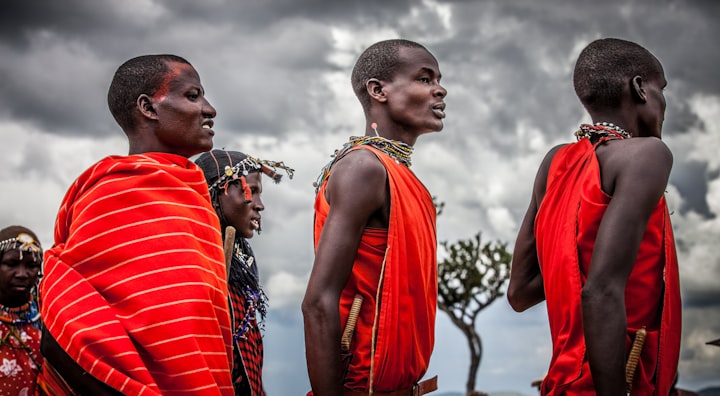African cultures have a rich history of unique and fascinating rituals. Some of these rituals are still practiced today, despite modernization and globalization. Here are 10 bizarre African rituals that are still practiced today: from the lip-stretching of the Mursi tribe in Ethiopia to the Ulwaluko rite of passage ritual by the Xhosa people in South Africa. These rituals range from the beautification of the body to the honoring of ancestors, and they offer a glimpse into the diverse cultures and traditions of Africa.
1 Bull Jumping
Bull jumping is a traditional practice among the Hamar people of Ethiopia; it's a rite of passage for young men to demonstrate their bravery and strength. The practice involves jumping over a row of bulls, one after the other, in a single leap. The bulls are lined up side by side, and the jumper must land on the other side without touching any of the bulls. The practice is usually done as part of a larger ceremony that includes rituals, singing, and dancing.
The bull jumping ceremony is a significant event for the Hamar people, as it marks the transition of the young men into adulthood and is also an important way for them to gain acceptance and respect from the community. The bull jumping tradition is still practiced today among the Hamar people of Ethiopia, and it is considered to be an important aspect of their culture and heritage.
2 Lip Stretching
Lip stretching is a traditional practice among certain ethnic groups in Ethiopia and Sudan, particularly among the Mursi and Surma people. The practice involves the gradual stretching of the lower lip using a wooden or clay plate, which is inserted into the lip and gradually increased in size over time. The practice is usually performed on young women, and it is seen as a rite of passage into adulthood and a symbol of beauty and maturity.
Lip stretching is also considered a sign of wealth and status, as it is believed that the larger the lip plate, the more cattle a woman's family owns. The tradition is also a way to express identity, culture and tradition. However, it should be noted that the practice of lip stretching has been criticized by some as it causes significant discomfort and pain, and can lead to infection, scarring and difficulty speaking.
3 Exhumation
The Famadihana is a meaningful tradition among the Malagasy people of Madagascar where they exhume their deceased ancestors' remains and re-wrap them in fresh cloth before dancing with them. It is called "turning of the bones," and it's a way for the living to show honor and respect to their ancestors. This practice is usually held once every seven years and serves as an opportunity for the community to come together and celebrate the lives of their ancestors.
During the Famadihana, the remains are taken out of the tombs and re-wrapped in new cloth, symbolizing renewal and rejuvenation. The re-wrapped remains are then placed in a central location and danced around by the community, accompanied by music and singing. The Famadihana is considered an important event for the Malagasy people and a time for them to come together and seek blessings and guidance from their ancestors. The Famadihana is a significant aspect of Malagasy culture and heritage and is still practiced to this day.
4 Spitting
The Maasai tribe of Kenya and northern Tanzania has a unique approach to spitting as compared to other cultures. While in many cultures spitting is seen as a sign of irritation, disregard or disagreement, among the Maasai tribe it is a sign of blessing and respect. The Maasai people sit on their hands before shaking each other as a sign of endorsement and utmost respect, and they only spit on someone they hold in high regard.
The Maasai tribe believes that if they speak pleasant things about a newborn after it is born, the infant will be cursed and may not live a decent life, making this one of the most significant times when spitting is used. So, instead of jinxing the child’s good luck, they say bad things about the child, and spit on the child with the hope that this child will live a long, happy life. Spitting is additionally used to congratulate a bride. On the bride's wedding day, the father of the bride makes a show of spitting on her breasts and forehead in order to wish her luck and fertility.
5 Jumping Ceremony
The Adumu or Eunoto ceremony is a traditional jumping dance practiced by the Maasai people of Kenya and Tanzania, that is considered an essential rite of passage for young Maasai men as they transition from boyhood to adulthood. The ceremony typically takes place every seven years and can last for several weeks. The young men participating in the ceremony are called "Il-o-lpuik" or "age-set" and are required to perform the jumping dance known as the "Adumu," which is the centerpiece of the ceremony.
The young men dress in traditional Maasai attire for the Adumu, which includes a scarlet blanket slung over their shoulders and a colorful shuka (cloth) wrapped around their waists. They enter a circular arena and start jumping as high as they can, competing to see who can jump the highest. Jumping is seen as a display of strength and athleticism and also represents the young men's determination to defend their community and cattle. The Adumu ritual is a significant cultural occasion for the Maasai people, as it marks a milestone in the young men's lives and signifies their readiness to take on adult responsibilities.
6 Kuomboka Festival
The Chewa people of Malawi, Zambia, and Mozambique have a unique custom known as the Kuomboka celebration, often referred to as the "Emerging Out of the Water" festival. This holiday serves as a time to remember and pay tribute to loved ones who have passed away, as well as to signify the passage of their spirits from this world into the next. It often occurs during the dry season, when it is said that the dead briefly rejoin the living.
Litunga, the king of the Malozi, is said to have his spirit taken across a river during the celebration as a representation of his spirit departing the world of the living and returning to the world of the dead. A traditional leader, who is considered to be the conduit between the living and the dead, leads the event. For the Chewa people, the Kuomboka festival is a special occasion. It is a time for the community to come together, honor the lives of their ancestors, and ask for their blessings and guidance. Many Chewa villages continue to celebrate the festival, which is regarded as an essential part of the Chewa tradition and legacy.
7 “Sharo” Beating to Earn a Wife
The "Sharo" ceremony, also known as "beating to earn a wife," is customary among the Fulani people of West Africa, who also inhabit Nigeria, Mali, and Senegal. As part of a rite of passage, young men must endure a harsh beating in order to prove their bravery and commitment and to be eligible for marriage.
The practice has garnered criticism since it is seen as a form of violence and is connected to the rise in domestic violence and abuse, even though some Fulani communities still engage in it today. It's critical to recognize that not all Fulani ethnic groups participate in this activity, and that younger generations are becoming less inclined to do so.
8 Reed Dance
Mkhosi wohMlanga, also known as the Reed Dance ceremony, is an annual event held in South Africa to celebrate virginity and womanhood among young girls and women. The ceremony, which is a tradition of the Zulu people, involves young girls and women cutting reeds from a nearby river and carrying them to the royal palace, where they are presented to the king as a symbol of their virginity and chastity.
The ritual is a major occasion in Zulu culture since it is thought to advance moral principles and fortify the relationship between the king and his subjects. The young ladies and girls who take part in the event are seen as role models for the community, and their participation is seen as a means of highlighting the significance of maintaining traditional values and practices. Participants sing and dance to the beat of drums and other instruments during the ceremony, which is a colorful and lively occasion. It is a special occasion that highlights the Zulu people's rich cultural heritage.
9 Courtship Dance
The Yaake, also known as the courtship dance of the Wodaabe, is a spectacular, colorful and lively display of traditional culture, beauty, and humor. The Wodaabe are a nomadic people of the Sahel region in Africa, and the Yaake is an important part of their culture and customs. The dance is usually performed by young men who dress in traditional clothing, adorned with colorful beads and paint their faces with intricate designs. They will dance and sing in front of a group of young women, trying to catch their attention and win their favor.
The Yaake is not only a way for the Wodaabe to find a mate, but it is also a way for them to show off their beauty, skills, and sense of humor to others. The dance is a way of expressing their culture and customs and is considered one of the most spectacular, colorful and entertaining dance performances in Africa. The women also dress in traditional clothing and adorn themselves with jewelry and accessories and they will often choose the most attractive and skilled dancer as a potential partner. But sometimes, the most hilarious and entertaining dancer might win the woman's heart. The Yaake is performed during the Gerewol festival, which is an annual event that brings together different Wodaabe clans.
10 Circumcision
The Xhosa people in South Africa have a special tradition called Ulwaluko, or the Xhosa initiation ritual. It's a big milestone for young boys as they become men and adults. The process can take a few weeks and usually starts when the boys are around 18 years old. They go to a secluded spot, usually in the mountains, where traditional healers called "Ingcibi" perform their circumcision. It's a tough and painful experience, but it's seen as necessary to becoming a man.
After the circumcision, the boys spend several weeks in isolation learning about Xhosa customs, beliefs and responsibilities of being a Xhosa man. They also learn about their culture, history, and the importance of family, community and respect. They are taught about traditional healers and diviners and how to perform traditional dances and songs. Once the initiation is over, the boys are considered men and welcomed back into their communities as full members. The Xhosa initiation ritual is an important part of their culture and tradition. It helps preserve their heritage and identity. It is still practiced today and holds a special place in Xhosa culture.
About the Creator
Charnelle
Hey! I'm Charnelle, owner of Techie Dome. My blog offers tips on earning passive income, creating online businesses, and reviews of the latest AI powered tools to help you find the best solutions for your business.







Comments
There are no comments for this story
Be the first to respond and start the conversation.